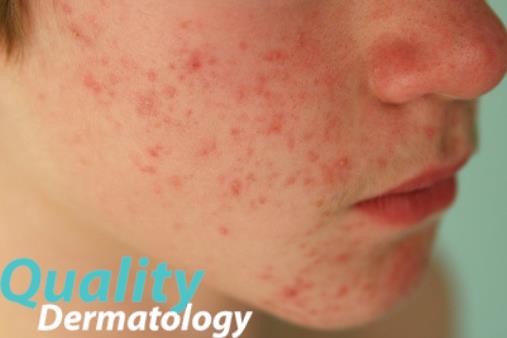Facial redness – rosacea
Rosacea is a common skin disease that presents as facial redness. It is a tendency to blush or flush more easily than other people. Sometimes facial rosacea presents with pimples. The facial redness usually is a classic sign of rosacea but the redness can slowly spread beyond the nose and cheeks to the forehead, chin, ears, chest, and back.
Types of rosacea:

- Erythematotelangiectatic rosacea: Redness, flushing, visible blood vessels.
- Papulopustular rosacea: Redness, swelling, and acne-like breakouts.
- Phymatous rosacea: Skin thickens and has a bumpy texture.
- Ocular rosacea: Eyes red and irritated, eyelids can be swollen, and person may have what looks like a sty.
If your dermatologist or clinic suspects you have rosacea, you won’t need medical tests because no medical test can tell whether you have rosacea. To diagnose rosacea, your dermatologist or clinic professional will examine your skin and eyes. Your dermatologist or clinic will also ask questions just to make sure you don’t have another medical condition that mimics rosacea. Sometimes some medical tests will be ordered by your doctor or clinic to rule out conditions, such as lupus and an allergic skin reaction.
There is no cure for rosacea. It is treatable though. While treatment cannot cure rosacea, it can help to reduce signs of rosacea, improve or eliminate pimples, and prevent rosacea from worsening.
Rosacea treatment
Education is always paramount. While medicine or laser treatment can help reduce or clear signs of rosacea, everyday habits may cause a new flare-up. So before treatment for rosacea is initiated you need to know about rosacea triggers. Triggers include:
Foods Temperature-related

- Liver
- Yogurt
- Sour cream
- Cheese (except cottage cheese)
- Chocolate
- Vanilla
- Soy sauce
- Yeast extract (bread is OK)
- Vinegar
- Eggplant
- Avocados
- Spinach
- Broad-leaf beans and pods, including lima, navy or pea
- Citrus fruits, tomatoes, bananas, red plums, raisins or figs
- Spicy and thermally hot foods
- Foods high in histamine
- Saunas
- Hot baths
- Simple overheating
- Excessively warm environments
Weather

- Sun
- Strong winds
- Cold
- Humidity
Drugs
- Vasodilators
- Topical steroids
Beverages Medical conditions
- Alcohol, especially red wine, beer, bourbon, gin, vodka or champagne
- Hot drinks, including hot cider, hot chocolate, coffee or tea • Frequent flushing
- Menopause
- Chronic cough
- Caffeine withdrawal syndrome
Emotional influences Physical exertion
- Stress
- Anxiety
- Exercise
- “Lift and load” jobs
Skin care products
- Some cosmetics and hair sprays, especially those containing alcohol, witch hazel or fragrances
- Hydro-alcoholic or acetone substances
- Any substance that causes redness or stinging
People who have rosacea have to protect themselves from sun. It is necessary to:
- Apply a broad-spectrum sunscreen with an SPF 30 (or higher) every day before you head outdoors
- Avoid the midday sun
- Seek shade when outdoors
- Slip on a wide-brimmed hat when outdoors to protect your face and neck from the sun
- Wear sun-protective clothing and sunglasses
Many skin care products can irritate skin with rosacea. Some skin care habits, such as scrubbing your skin clean, can cause rosacea to flare. Using mild skin care products and being gentle with your skin can help prevent flare-ups. If you have trouble finding mild skin care products, ask your dermatologist or skin clinic for recommendations.
There is no cure for rosacea, but you can successfully control it. Making some lifestyle changes and treating rosacea with topical and sometimes oral therapy can prevent flare-ups. It can also prevent the rosacea from worsening.
Rosacea stages
Mild Rosacea – Stage I
Redness of the facial skin is chronic. Redness of various facial areas lasting only a few minutes. Telangiectasia or spidery blood vessels are barely noticeable.
Moderate Rosacea – Stage II
Redness of the facial skin is chronic. Rosacea papules begin to appear. The rosacea papules, that come and go, do not have pus or a bacterial component. Inflammatory papules (without pus) and pustules (with pus) develop and continue to worsen. Facial pores often become larger and more prominent. The sebaceous gland pores become larger. Sun damaged skin appears more prominent with the dry leathery, wrinkled appearance. Scarring can result. Areas affected can be localized such as on the nose or cheeks or it can cover the entire face. In extreme cases, some of the more advanced rosacea pustules can began to appear on the scalp, chest and the neck.
Severe Rosacea – Stage III
Redness of the facial skin is chronic. This type of rosacea may have furuncle or boils due to the infected sebaceous gland within the hair follicle on the face or neck. Over time, the skin becomes course and thicker and more red and inflamed sometimes with prominent bulbulous nose of rhinophyma. Sometimes patients require antibiotics or even surgical optional modalities for severe cases.
If there has been much sun exposure damage over the years, the skin becomes more leathery skin becomes more wrinkled as it is not elastic or as soft to bend. It is often the cumulative effect of the treatments you’ve been using that may actually be the aggravating source or factor of your current treatment. Improving the skin involves a complete change in your thought processes and your approach to treating your facial skin condition. Effective rosacea treatment and skin care also involves preventive skin care. The use of sun screens is just one of these preventive skin care treatment measures. For some people with rosacea, no matter what they try to treat their rosacea symptoms, their skin does not seem to respond.
